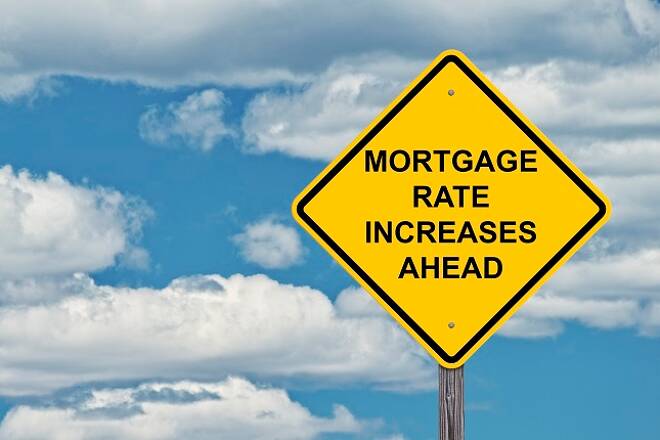Advertisement
Advertisement
U.S Mortgages – A Weekly Jump Adds More Pressure on the Housing Sector
By:
With mortgage rates now knocking on the door of 5%, geo-political risk could see more upside for yields and rates, the Housing Sector in the cross-fires.
U.S mortgage rates took a wild leap in the week ending 11th October, with the 30-year fixed mortgage rate surging by 19 basis points to 4.90%, the highest level since 14th April 2011, according to Freddie Mac’s latest weekly report.
The weekly jump certainly brought mortgage rates back in line with the upward trend in U.S 10-year Treasury yields, last week’s hold on rates an anomaly when considering the 7-year highs in Treasury yields through the week.
This week’s mortgage rate moves certainly compensated for last week’s muted response, with economic data released through to Thursday’s close being on the lighter side and ultimately having little to no impact on Treasury yields and the direction of mortgage rates for that matter.
Key stats through the week were limited to September wholesale and consumer price inflation figures, along with the weekly jobless claims numbers, softer annual inflation rates providing mortgage rates from little shelter from the ongoing move towards 5%.
Outside of the numbers, a glowing review of the U.S economy by FED Chair Powell contributed to the jump in Treasury yields, the view on the U.S economy supporting the more hawkish FOMC rate path projections that see rate hikes continuing through December and next year.
FED Chair Powell’s comments came in spite of market volatility, with rising tensions between the U.S and China and the IMF’s latest growth forecast downgrades for this year and next seemingly having little influence as the U.S economy powers ahead.
If there were concerns previously over affordability, the latest jump in mortgage rates, coupled with falling demand, attributed to higher rates and rising home prices, will certainly turn the screw for prospective home buyers and that not going to be a good thing for the housing sector, which is considered to be a barometer of the U.S economy. Debate of the real estate sector has garnered more airtime, though by historical standards, the current mortgage rate environment is less of an issue, the lack of wage growth and inventories being of greater concern.
Freddie Mac weekly average rates for new mortgages as of 11th October were quoted to be:
- 30-year fixed rate loan jumped from 4.71% to 4.90% in the week, while up from 3.91% a year ago. The average fee rose from 0.4 points to 0.5 points.
- 15-year fixed rates increased from 4.15% to 4.29% in the week, while up from 3.21% from a year ago. The average fee increased from 0.4 points to 0.5 points.
- 5-year fixed rates increased from 4.01% to 4.07% in the week and up from last year’s 3.16%. The average fee held steady at 0.3 points.
Mortgage Bankers’ Association Rates for the week ending 5th October were quoted to be:
- Average interest rates for 30-year fixed, backed by the FHA, increased from 4.95% to 4.98%, its highest level since April 2011, with points decreasing from 0.80 to 0.63 (incl. origination fee) for 80% LTV loans.
- Average interest rates for 30-year fixed with conforming loan balances eased from 4.96% to 5.05%, its highest level since February 2011, with points rising from 0.49 to 0.51 (incl. origination fee) for 80% LTV loans.
- Average 30-year rates for jumbo loan balances increased from 4.93% to 4.99%, its highest level since July 2011, with points increasing from 0.31 to 0.35 (incl. origination fee) for 80% LTV loans.
Weekly figures released by the Mortgage bankers Association showed that the Market Composite Index, which is a measure of mortgage loan application volume, slid by 1.7% in the week ending 5th October following on from the previous week’s hold steady, week-on-week.
The Refinance Index slid by 3%, in the week ending 5th October, following the previous week’s 0.1% fall, with the share of refinance mortgages remained unchanged at 39.4%.
The Mortgage Bankers Association also released its September figures for new home purchase mortgage applications on 11th October.
- Mortgage applications for new homes rose by 8.2% in September 2017, compared with September 2017, whilst down 9% when compared with August 2018.
- The MBA views September’s year-on-year rise of 8.2% in applications as supportive of continued demand for new homes, in spite of rising mortgage rates.
- Seasonally adjusted, the MBA estimated a 3.9% fall in the number of new single family home sales compared with August.
For the week ahead, it’s a busy economic calendar, with September retail sales and manufacturing numbers scheduled for release along with the ever increasingly important JOLTs job openings and housing sector data. With so much speculation on whether the housing sector has begun to hit the brakes, September’s building permit, housing start and existing home sales figures will provide some further evidence on whether mortgage rates have begun to bite, September seeing mortgage rates resume an upward trend that reversed the downward trend through August with interest.
About the Author
Bob Masonauthor
With over 28 years of experience in the financial industry, Bob has worked with various global rating agencies and multinational banks. Currently he is covering currencies, commodities, alternative asset classes and global equities, focusing mostly on European and Asian markets.
Advertisement
